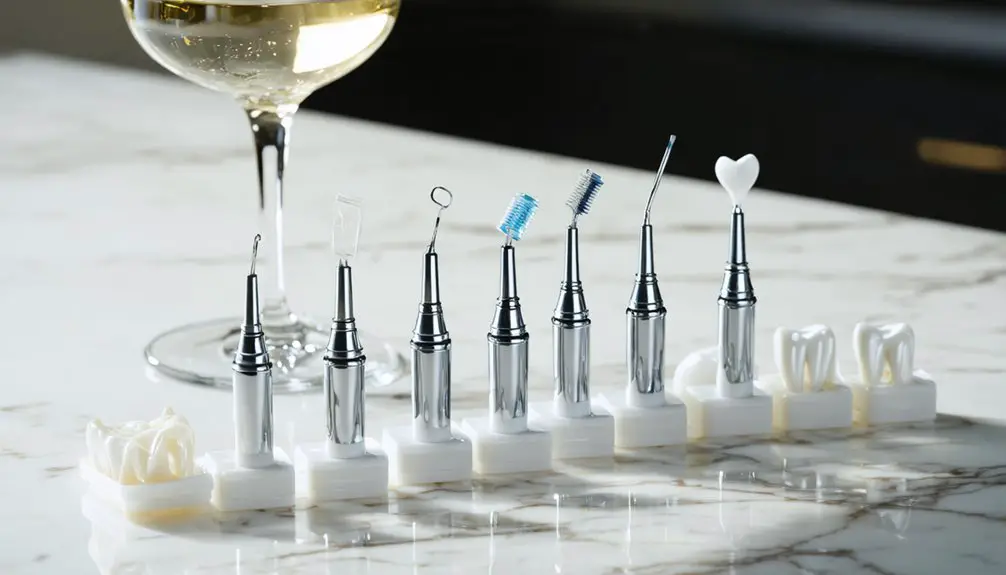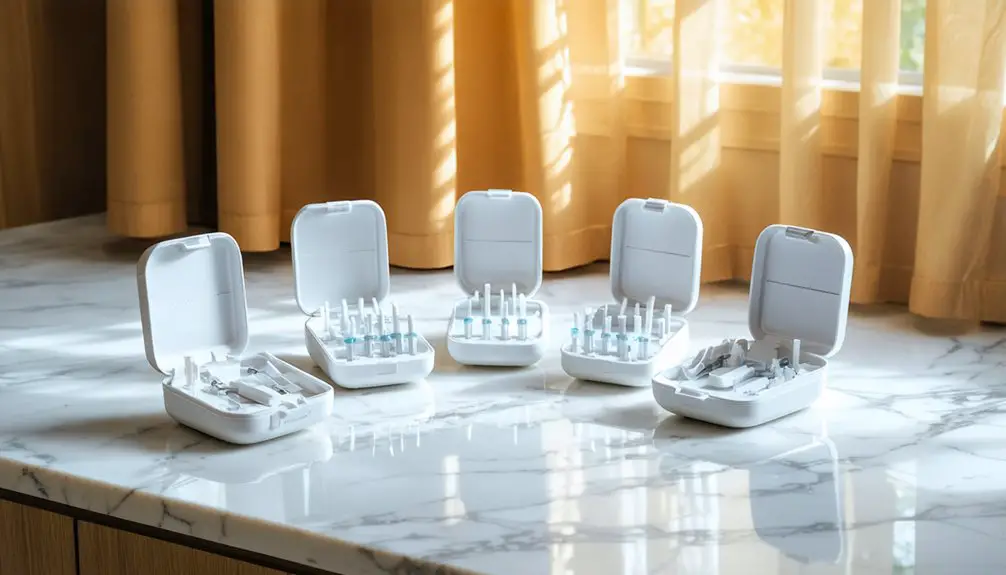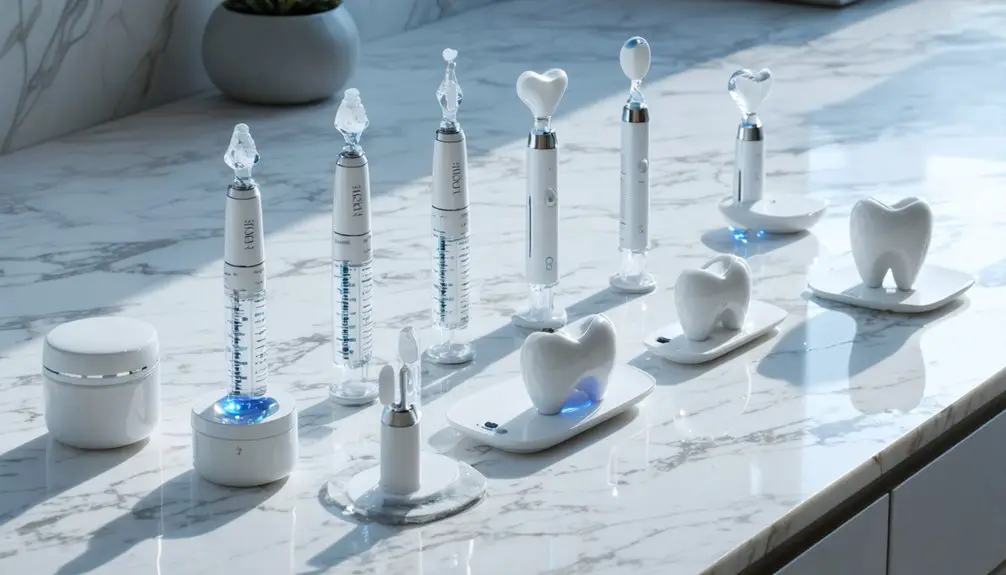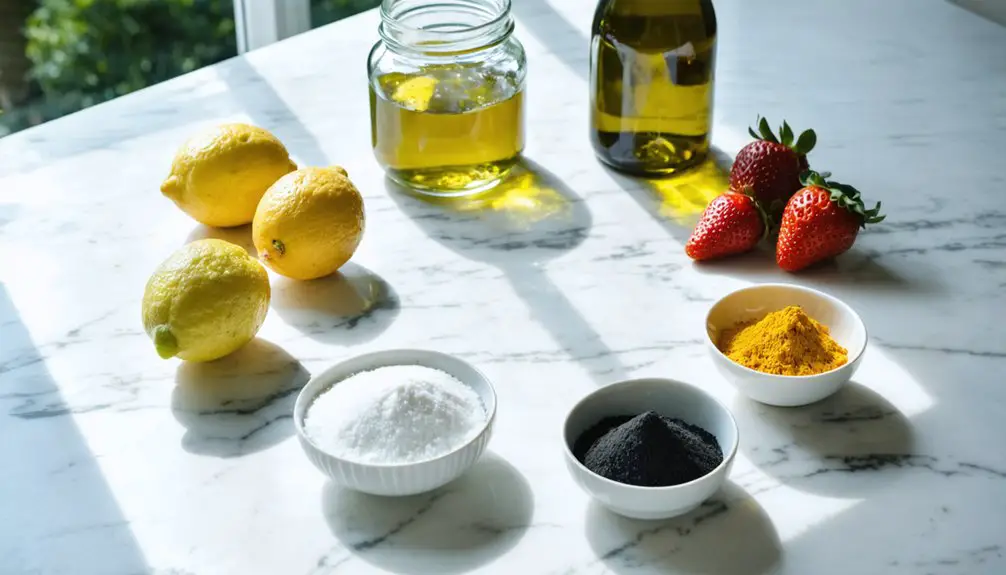For wine-stained teeth, you’ll find the most effective at-home whitening solutions in LED-enhanced systems and professional-grade strips. Crest 3D Whitestrips Professional Express leads the pack, delivering up to 2.6 shades whiter in 19 days. Other top performers include iSmile, MySmile, and Zimba kits, which combine peroxide formulations with LED technology. Your ideal choice depends on sensitivity levels and desired results, with detailed comparisons revealing important differences between systems.
Key Takeaways
- Crest 3D Whitestrips Professional Express achieves 2.6 shade improvement within 19 days and effectively removes wine stains.
- LED-enhanced whitening systems with hydrogen peroxide provide rapid results by accelerating the bleaching process for wine stains.
- iSmile and MySmile kits offer professional-grade formulations at $28-$50, making them affordable alternatives to expensive treatments.
- Custom-fitted whitening trays ensure even application and minimize gum exposure while targeting stubborn wine discoloration.
- Walmart’s LED light kits with whitening gel pens start at $23 and receive high satisfaction ratings of 4.8-4.9/5.
Understanding Wine’s Impact on Tooth Discoloration
While many wine enthusiasts focus on the beverage’s taste and aroma, its impact on dental health warrants equal attention.
When you drink wine, you’re exposing your teeth to a complex interplay of compounds that can lead to staining. Wine acidity softens your tooth enamel, making it more susceptible to discoloration, while tannin effects create binding sites for pigments to attach. Pairing with cheese can help neutralize wine’s acidic effects on teeth.
Wine’s acidic nature softens enamel while its tannins create attachment points, making teeth vulnerable to deep staining.
Red wine poses a particular challenge due to its higher concentration of tannins and chromogens, which create both immediate and long-term staining. Sugar-free gum chewing after drinking wine can help stimulate protective saliva production.
Even white wine, though less pigmented, can weaken enamel through acid exposure. You’ll find that these staining mechanisms become more pronounced with frequent wine consumption, especially if you’ve recently had your teeth whitened.
Understanding these processes helps you make informed decisions about protective measures and whitening treatments.
Best Professional-Grade Whitening Systems
Professional LED whitening systems can effectively combat wine stains by accelerating the bleaching process through targeted light activation.
You’ll find these systems pair well with high-concentration peroxide solutions, which break down deep-set stains more efficiently than over-the-counter alternatives.
The combination of LED technology and professional-grade peroxide allows for faster results while maintaining safety through adjustable intensity settings and customized treatment protocols. Custom-fitted trays ensure even application and minimize gum contact during the whitening process. The Crest 3D Whitestrips Professional Express with LED light can whiten teeth up to 2.6 shades lighter in less than three weeks of use.
LED Systems’ Whitening Power
Three key factors make LED-activated whitening systems a powerful choice for removing wine stains: their ability to accelerate peroxide reactions, achieve significant shade improvements, and deliver customizable treatment intensities.
When you’re targeting stubborn wine stains, LED effectiveness comes from amplifying the whitening agents during their vital 24-hour active period. Recent studies demonstrate that chemical agents alone produce equivalent whitening results without LED activation.
Clinical studies show improvements of 1.0 to 5.3 units in tooth brightness (ΔL*), with the best results occurring when higher peroxide concentrations meet LED activation.
You’ll see the most dramatic results – up to 6-8 shades lighter – when using professional-grade systems that combine LED technology with potent whitening gels. The cool blue light technology ensures maximum effectiveness while maintaining patient comfort during treatment.
Modern LED devices now offer adjustable wavelengths to match your specific staining patterns, while maintaining comfort and safety throughout the treatment process.
High-Concentration Peroxide Solutions
For ideal wine stain removal, high-concentration peroxide solutions ranging from 35-40% deliver superior results compared to over-the-counter alternatives.
These professional-grade treatments penetrate deep into your enamel, effectively oxidizing stubborn wine stains through powerful chemical reactions that create true color changes rather than surface-level cleaning. Tooth enamel acts like a sponge, allowing deeper hydrogen peroxide penetration for more thorough whitening results.
Regular dental cleaning before treatment ensures uniform whitening across all teeth surfaces.
While high concentration effectiveness is notable, you’ll need professional supervision to guarantee peroxide safety.
The increased potency can cause tooth sensitivity and enamel softening if not properly managed. Your dentist will typically combine in-office treatment with take-home maintenance using lower concentrations to extend results while minimizing sensitivity.
Remember that successful whitening depends on both concentration and application time – following your dental professional’s guidelines precisely will help you achieve prime results without compromising your enamel’s integrity.
LED Technology in Modern Whitening Kits
Modern LED technology has revolutionized at-home teeth whitening by accelerating the bleaching process through specific light wavelengths. The LED advantages include faster treatment times, reducing sessions from hours to just 30 minutes, while maximizing the effectiveness of peroxide gels on wine-stained teeth. Unlike older UV systems, LED dental lights provide safe and energy-efficient whitening without cancer risks.
When you use LED whitening technology, blue or indigo light activates the peroxide gel, penetrating your tooth enamel to break down stubborn stains. You’ll typically see improvements of 6-8 shades in a single session, with the most noticeable results in reducing yellow discoloration. Most treatments require just 10 to 30 minutes per session for optimal results.
While temporary sensitivity affects about 50% of users, it usually resolves within 24 hours. The portable design and consistent light output guarantee uniform bleaching, making it an efficient option for maintaining your smile between professional treatments.
Comparing Peroxide Vs Non-Peroxide Solutions
When choosing between peroxide and non-peroxide teeth whitening solutions, you’ll need to weigh their distinct mechanisms and effectiveness.
Peroxide advantages include superior deep-stain removal and faster results, particularly effective for stubborn wine discoloration. Non-peroxide benefits focus on gentler whitening with reduced sensitivity, making them ideal for patients with delicate teeth or those requiring long-term maintenance.
- You’ll achieve faster, more dramatic results with peroxide-based solutions, helping your clients see immediate improvement.
- Your sensitive patients will experience considerably less discomfort with non-peroxide options.
- You can confidently recommend non-peroxide solutions for safe, long-term use without risking enamel damage.
- Your clients with deep wine stains will benefit most from peroxide’s penetrative oxidizing action.
Time-Tested Brands and Their Results
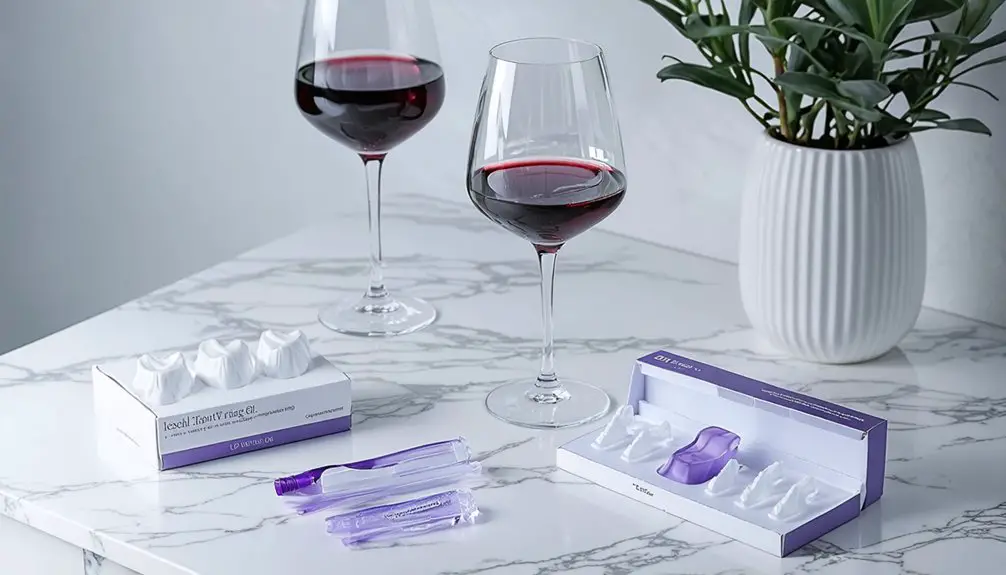
Leading teeth whitening brands have demonstrated consistent results through rigorous clinical testing and consumer feedback. The time-tested efficacy of products like Crest 3D Whitestrips Professional Express shows measurable improvements, with users experiencing an average 2.6 shade enhancement over 19 days.
Their LED-enhanced system has proven particularly effective for wine stain removal.
Consumer feedback confirms the value of established brands, with clinical studies reporting 74% brightness increases and 100% satisfaction rates. You’ll find that hydrogen peroxide-based solutions remain the most reliable choice, especially when combined with LED technology.
While newer entries like Dr. Brite’s Natural Whitening Pen promise results, products with documented clinical outcomes offer more predictable results. The most successful options deliver noticeable improvements within one week while maintaining excellent safety profiles with minimal sensitivity reports.
Safety Features and Sensitivity Prevention
While established brands offer proven results, safety remains paramount when selecting teeth whitening products for wine stains.
You’ll need to follow strict safety protocols and implement proper sensitivity management techniques to guarantee successful treatment without complications. Look for products with the ADA seal and custom-fitted trays that minimize gum exposure to whitening agents.
- Your teeth deserve gentle care – start with shorter treatment sessions to assess sensitivity levels
- You’re protecting your patients by recommending gradual exposure and monitoring their response
- You’ll prevent complications by guaranteeing proper tray fit and even application
- Your guidance helps others avoid the risks of overuse and excessive peroxide exposure
Begin treatments gradually, take breaks between sessions, and use desensitizing agents when needed.
If severe sensitivity occurs, discontinue use immediately and consult a dental professional.
Cost-Effective Options That Actually Work
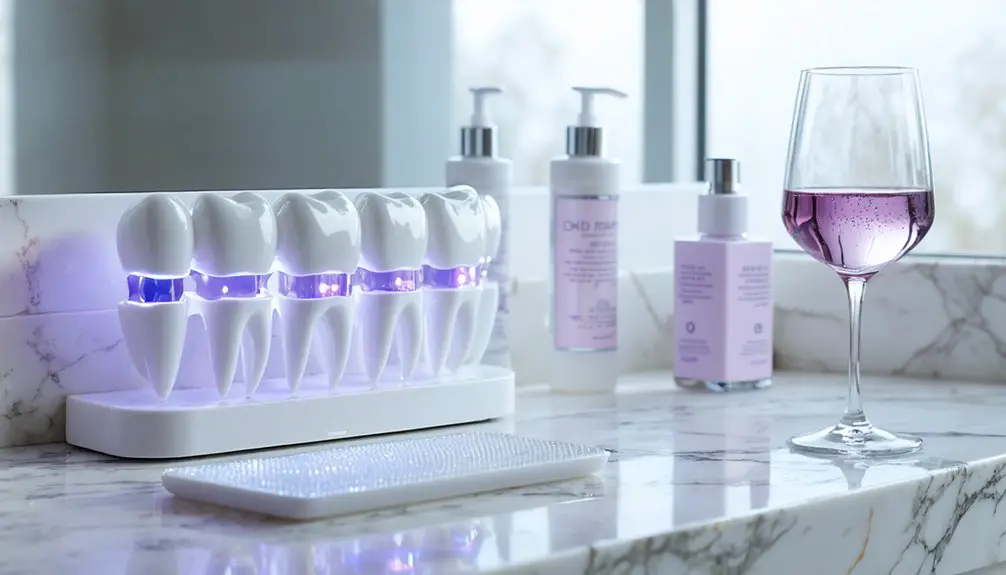
Despite the common belief that effective teeth whitening requires expensive professional treatments, several affordable at-home kits deliver impressive results for wine-stained teeth.
Product comparisons reveal that Crest 3D Whitestrips Professional Express Kit, priced at $60, achieves notable results within 19 days without causing sensitivity.
For even more budget-conscious options, you’ll find the iSmile kit ($28-$50) and MySmile systems ($24-$50) offering professional-grade formulations with high user satisfaction ratings of 4.8-4.9 out of 5.
These kits feature LED technology and clinical-grade whitening gels that effectively target wine stains.
Walmart’s bestselling options start at just $23, combining LED lights with whitening gel pens, while Zimba provides natural formulations at a fraction of professional treatment costs.
Frequently Asked Questions
Can I Drink Red Wine During the Whitening Treatment Period?
You shouldn’t drink red wine during whitening treatment, as it’ll interfere with whitening ingredients and reverse your results. Focus on stain prevention by avoiding wine until your treatment’s complete.
How Long Should I Wait After Whitening Before Drinking Wine Again?
Time is of the essence – you’ll need to wait 24-48 hours minimum after whitening before drinking wine. For ideal whitening frequency and wine stain prevention, it’s best to wait a full week.
Will Whitening Kits Remove White Wine Stains as Effectively as Red?
Since white wine doesn’t create direct pigment stains like red wine, teeth whitening kits won’t show as dramatic results. They’ll mainly address the erosion-related discoloration that white wine causes to your enamel.
Do At-Home Wine Stain Removers Work as Well as Dentist Treatments?
Like a gentle stream versus a rushing river, your at-home wine stain removers won’t match the effectiveness of professional treatments. You’ll see slower, more subtle results compared to dentist-administered whitening procedures.
Should I Brush Teeth Immediately Before Applying Whitening Products for Wine Stains?
You’ll want to brush gently 30 minutes before whitening, using a soft-bristled brushing technique and non-abrasive toothpaste. This timing helps prevent whitening sensitivity while ensuring clean teeth for ideal results.
References
- https://www.goodhousekeeping.com/health-products/g28723133/best-at-home-teeth-whitening-products/
- https://shopismile.com/products/deluxe-home-teeth-whitening-system
- https://deandentalsolutions.com/the-best-at-home-teeth-whitening-worth-trying/
- https://www.walmart.com/browse/personal-care/teeth-whitening-kits/1005862_1007221_1044034_1989450
- https://www.mylaughland.com/products/at-home-whitening-kit
- https://www.rocklanddentalspecialists.com/can-wine-stain-your-teeth/
- https://pmc.ncbi.nlm.nih.gov/articles/PMC9683888/
- https://greenacresfamilydental.com/the-cavity-showdown-coffee-vs-wine-which-ruins-your-teeth-most/
- https://pmc.ncbi.nlm.nih.gov/articles/PMC4054058/
- https://proglowteethwhitening.ca/top-10-foods-and-drinks-that-will-stain-your-teeth/
